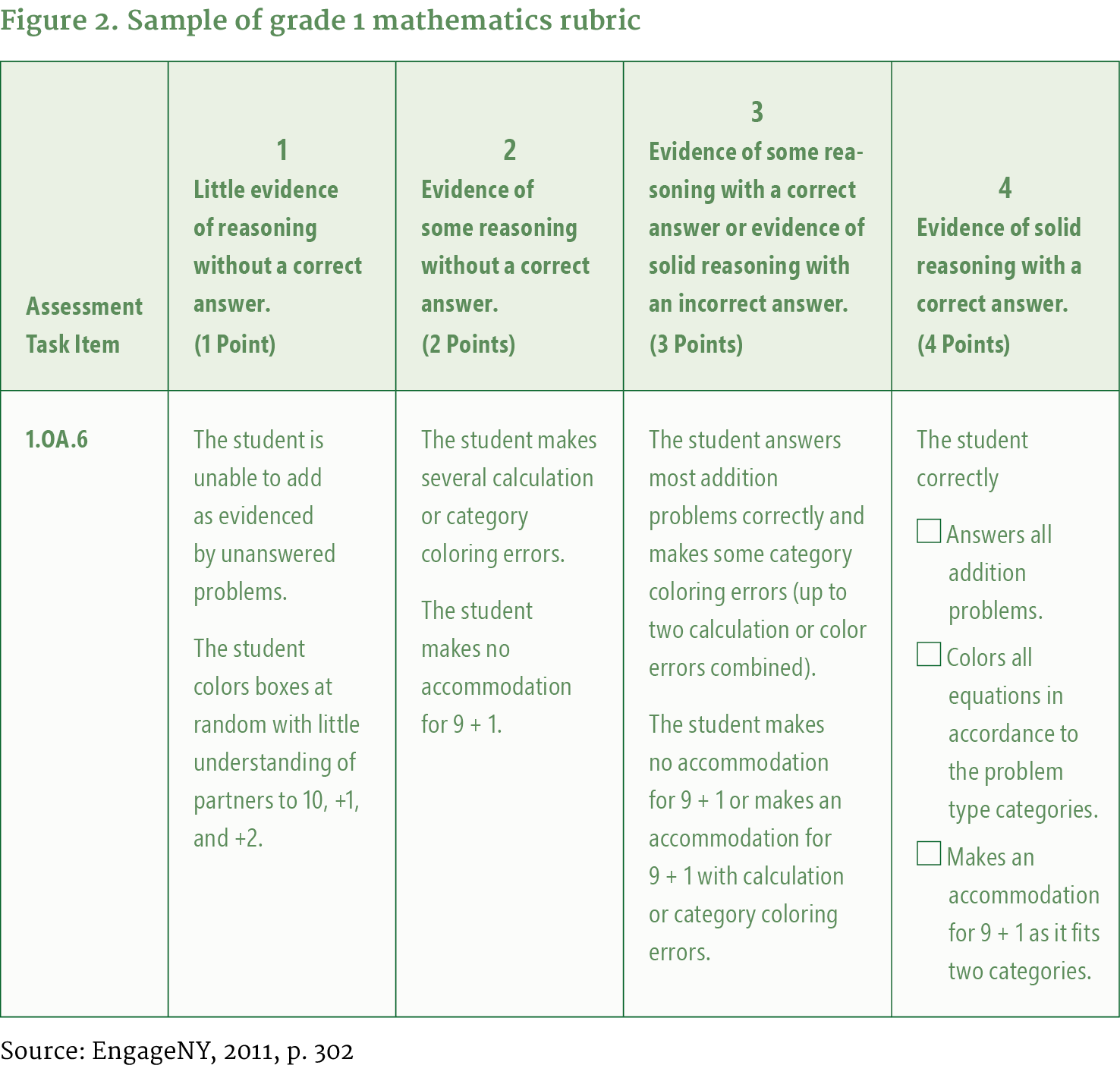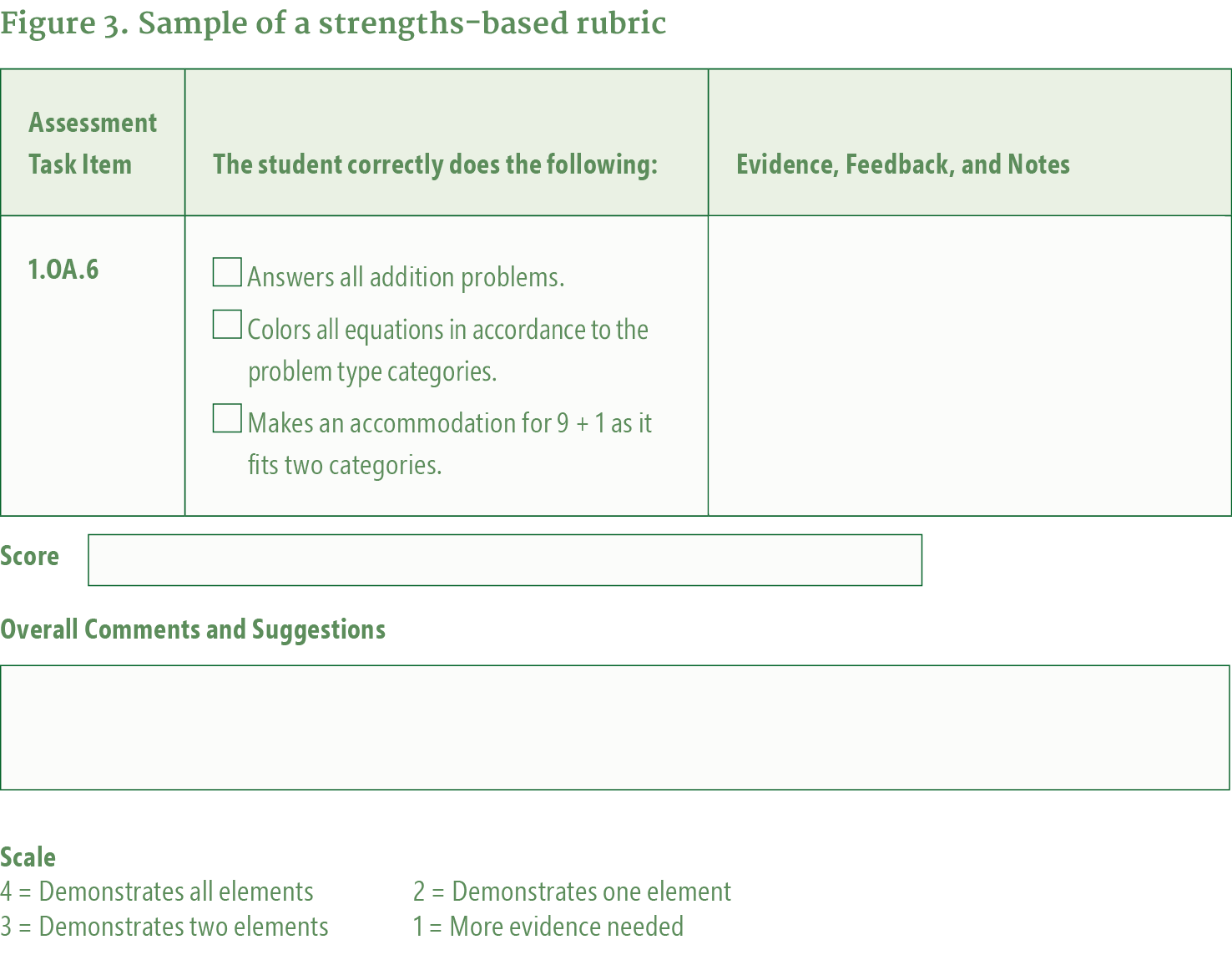A Strengths-Based Approach to Assessment Rubrics
Posted on by Kevin Perks, Robert Rosenfeld

By Kevin Perks, Director of School and District Services, and Robert Rosenfeld, Senior Engagement Manager, with WestEd’s Quality Schools and Districts team. This article originally appeared in the LEAF Subscription for Professional Learning, Volume 5, Issue 5, in 2019. It is posted here with permission.
Approaching teaching and learning from a strengths-based mindset can look very different from teaching and learning that is generated through a deficit-based mindset. Unfortunately, deficit-based approaches are pervasive and can undermine attempts to promote equity, improve schools, and increase student achievement (Valencia, 2010). In this article, we briefly define both mindsets and summarize why a strengths-based approach to teaching and learning is preferable.
To demonstrate the differences, we describe how standards-based assessment rubrics tend to emphasize a deficit-based mindset, and we show how such rubrics can be improved by focusing more on strengths than on weaknesses and by providing helpful feedback to students. We also suggest additional steps that districts and schools can take to shift toward greater strengths-based practices.
Strengths-Based Approaches Versus Deficit-Based Approaches
A strengths-based (sometimes referred to as asset-based) approach to teaching and learning emphasizes and focuses on the positive aspects of students’ effort, performance, and achievement (Lopez & Louis, 2009, p. 1). The mindset behind such an approach defines students by their strengths and achievements, not their failures. Teachers with this mindset view learning and development as a progression in which learners continuously build on existing knowledge and work to enhance or refine their skills.
A strengths-based mindset begins with looking at what a learner is able to do and from there, sets goals to drive new learning (Valencia, 2010). By contrast, a deficit-based approach to teaching and learning is grounded in a mindset that focuses on what is “bad” or is not being learned (Shushok & Hulme, 2006). This mindset defines students based on their weaknesses and/or failures, not their strengths (McKay & Devlin, 2016). Such an approach encourages a model of pathology in which anyone who is not able to learn what educators think they should learn in an expected manner and time frame must be wrong, behind, or deficient. A deficit-based mindset begins with expecting a certain level of attainment and considers the learner from this perspective.
A key difference between a strengths-based approach and a deficit-based approach is that the latter separates students into two distinct groups: those who can and those who cannot. Such division drives what some have called the Matthew effect (Rigney, 2010). The Matthew effect refers to the biblical adage “the rich get richer and the poor get poorer.”
When teachers assess student performance from a deficit-based mindset, the focus for students who did not meet expectations or standards is aimed backward on what they did not learn. Subsequent teaching is likely to focus on filling these gaps. By comparison, for students who met or exceeded the standard, the teacher’s focus is oriented forward on learning new knowledge and skills. Thus, for students who achieve proficiency according to pre-determined norms, the focus is to continue moving forward, whereas for students who did not meet these norms, momentum is stalled and the focus is oriented backward.
The Matthew effect is less likely to happen when the assessment of student learning is based on a strengths-based mindset. From this perspective, after students have demonstrated their learning, the teacher identifies what each student is able to do and works with students to set new goals to continue forward momentum. A teacher with this mindset understands that all students learn at different paces and in different ways. During demonstrations of learning, the teacher gathers and uses data to continue looking forward by setting goals to drive new learning based on what students have demonstrated they are able to do—not on what they cannot do. This approach sends a message to all students that they are capable of learning, even when they learn at different rates. The learning orientation for everyone is always forward.
The differences between strengths-based and deficit-based approaches to teaching and learning are not just semantic. The way people think shapes how they communicate and act. In education, one area where the influence of mindsets is most evident is in how students are assessed. In the following sections, we explore how rubrics that are used for assessing student learning are designed and implemented differently depending on whether they come from a deficit-based or a strengths-based mindset.
Deficit-Based Rubrics
Rubrics are a common and often helpful type of resource that teachers use for assessing student work according to standards. Many rubrics take the form of grids, as shown in Figure 1. Typically the column headers describe progressive levels of performance. The number of performance levels varies, but having four levels seems to be common.
Often, the first two levels indicate performance below an established standard, the third level describes proficient performance that meets the standard, and the fourth describes performance that exceeds expectations. The rows of a rubric typically have headers that identify the criteria or standards being measured, and the cells in each row describe the levels of performance for that row’s criterion or standard.
The vast majority of rubrics we see being used in classrooms are designed from a deficit-based mindset. These rubrics use a language of deficit to describe levels of performance below proficiency. Such language can appear both in the labels for the levels of performance and in the descriptors of below-standard performance.
For example, a quick scan of sample rubrics found online yields hundreds of rubrics that label four levels of performance with phrases like the following:
» Does Not Meet, Partially Meets, Meets, Exceeds
» Failing, Basic, Proficient, Exceptional
» Poor, Fair, Good, Excellent
» Needs Improvement, Satisfactory, Good, Strong
In each set of the four levels, notice how the first level or two uses language that implies deficit or deficiency. Similar to the names given to each level, the descriptions for standards within the lower levels of performance frequently rely on language such as the following: poor, lacks, does not, missing, fails to, mistakes, low, weak, inconsistent, incoherent, problematic, serious errors, has trouble, no style, not balanced, unclear, incapable, unable, questionable, egregious.
From these examples, it is apparent that a significant portion of the language in typical rubrics focuses on what is wrong. Quantifying the negative impact such language has on students is difficult, but consider how you might feel if such language were used on your next performance evaluation to describe you or your work. How do you think most people would respond to the use of such language? What might the impact be if such language were used frequently?
To avoid approaching the assessment of student work through a prism of deficiency or negativity, what would a rubric written from a strengths-based mindset look like?

Shifting Toward Strengths-Based Rubrics
Rubrics built from a strengths-based mindset are different from those that focus on deficits, but the strengths-based rubrics can still validly assess learning, be standards-based, and provide helpful feedback to students. To demonstrate shifting to a strengths-based approach, we start with a rubric from the EngageNY* curriculum, a resource that may be familiar to many readers. EngageNY’s rubrics are stronger and more positive than most we tend to see being used in schools and districts. Nonetheless, an EngageNY rubric can help demonstrate how pervasive the language of deficit is, as well as how easily such a rubric can be adjusted to be more strengths-based.
Module 1 of the Grade 1 Mathematics Curriculum (EngageNY, 2011, p. 302) includes a rubric that has four levels of performance (Figure 2 shows a sample of the rubric). The rubric does not label the performance levels (other than numbering them) but does include a description of each. For this rubric, Level 4 defines proficiency; Levels 1, 2, and 3 describe performance below proficiency. There is no level defining work that is above proficiency. The row we selected to include in Figure 2 identifies 1.OA.6 as the standard being assessed, which is standard six for Operations and Algebraic Thinking from the New York State Mathematics Standards for Grade One:
Add and subtract within 20, demonstrating fluency for addition and subtraction within 10. Use strategies such as counting on; making ten (e.g., 8 + 6 = 8 + 2 + 4 = 10 + 4 = 14); decomposing a number leading to a ten (e.g., 13 – 4 = 13 – 3 – 1 = 10 – 1 = 9); using the relationship between addition and subtraction (e.g., knowing that 8 + 4 = 12, one knows 12 – 8 = 4); and creating equivalent but easier or known sums (e.g., adding 6 + 7 by creating the known equivalent 6 + 6 + 1 = 12 + 1 = 13).
The rubric excerpted in Figure 2 has less language of deficit than most we encounter in schools. However, it still contains evidence of a deficit-based mindset. For example, three of the four performance levels focus partly on what students are not able to do. The rubric also contains negative language such as the following: Little evidence of reasoning, unable to add, the student makes no accommodation, incorrect, errors, without a correct answer.

Consider the revised rubric in Figure 3 as an alternative to the one in Figure 2. Note that the rubric in Figure 3 defines proficiency in the same way as the rubric in Figure 2, but it eliminates all of the performance levels that describe student performance or work in negative or deficit-based terms. Teachers would use the revised rubric by checking off the elements of proficiency that a student demonstrates, leaving elements blank if there was insufficient evidence. This rubric has a feedback column where a teacher can then provide specific, differentiated, and student-centered feedback. In the space for feedback, a teacher could identify what a student may be struggling with and suggest support strategies.
The teacher could also include goals for new learning. There is also a place to include overall comments where teachers could describe what steps the student can take to continue his or her learning. In this way, the rubric is more forward-oriented than those in Figures 1 and 2, though it maintains the same four-level scale for scoring.
The revised rubric does not include any language of deficit. All language is positive or neutral and helps keep the focus on what students are, or will be, able to do. If no elements are checked off because a student’s work has not met any of the criteria, there is no emphasis on what they cannot do or any negative portrayals of their work. The descriptors that are left blank identify what the student has yet to learn.
Some may argue that revising the rubric in this way loses information; we disagree. A common problem with rubrics is that student work often does not precisely match the description within the performance levels, which can leave teachers struggling to find the level that is the best match. Why is it necessary to predict (often inaccurately) the way(s) in which students will fail? The revised rubric avoids this problem altogether by focusing solely on defining proficiency. Either a student has met a benchmark or not. If not, that benchmark will remain a focus for learning. The feedback boxes also encourage the teacher to provide differentiated feedback for each student. For students who do not demonstrate any of the elements of proficiency, the descriptor is “more evidence needed.” However, there is still space in the comment sections to add information describing where the student needs to go next in his or her learning.
When we work with educators and share rubrics like the one in Figure 3, the responses are overwhelmingly favorable and appreciative. In general, teachers tend to find rubrics like this one easier to use, more helpful, and less challenging to create. They are simpler to create because the main task is now focused on identifying the key criteria from the standards being assessed in order to clearly define proficiency. Teachers no longer need to wrestle with describing multiple levels of performance below proficiency and predicting the way(s) students might fail. And, as we described previously, removing the language of deficit makes the rubrics and approach only stronger.

Suggestions for District and School Leaders
There are a few steps that educational leaders interested in embracing a strengths-based approach to assessment rubrics can take. One initial step is to conduct a language of deficit audit of their district’s current assessment rubrics. Such an audit can be done by convening a small team to collect and analyze rubrics teachers are using in their classrooms. A quick scan of rubrics will indicate the extent to which rubric and assessment practices embrace deficit-based or strengths-based thinking.
Another step is to develop templates teachers can use for designing assessment rubrics. Once there are templates, teachers can be asked to ensure their rubrics have a strong resemblance to district-supported models. The rubric in Figure 3 is one template. Feel free to contact us for additional examples.
A third step that helps districts shift toward using strengths-based approaches in everyday practice, particularly those related to assessments and rubrics, is to build capacity and encourage teachers to collaboratively design assessments and rubrics, as well as to engage in the co-scoring of student work. When teachers use rubrics to score student work together, their overall assessment practices are likely to improve (Mertler, 2016). In addition, if a school or district is emphasizing strengths-based approaches over deficit-based approaches, then teachers can support one another when they notice each other using deficit-based language.
Conclusion
As mentioned at the beginning of this article, deficit-based approaches to teaching and learning are common in many schools and districts. While this article focuses on how educational leaders can shift toward strengths-based approaches and improve assessment practices using rubrics, there are many other ways that deficit-thinking permeates an educational community (e.g., Skrla & Scheurich, 2001). At the system level, a deficit-based mindset perpetuates inequity and discourages improvement because deficit thinking draws from an “ethnocentric notion that the beliefs and standards of the dominant group are inherently correct” and can encourage educators to “construe cultural, social, and linguistic differences as problems that originate in the home and over which educators have little influence” (Nelson & Guerra, 2014, p. 72). When children and families are viewed as deficient, educators may be reluctant to assume responsibility for low achievement among students (Berman & Chambliss, 2000). In addition, educators who hold deficit beliefs are more likely to resist improving their practices because they believe students and families are the source of educational challenges and achievement gaps (García & Guerra, 2004; Pohan & Aguilar, 2001; Valencia et al., 2001).
Understanding the difference between strengths-based and deficit-based thinking may help leaders notice when teaching and learning are being driven by deficit-based thinking. Once leaders are aware, they can act. The use of rubrics is one concrete area in which leaders can work with educators to shift practices in a way that can influence the entire education system.
*EngageNY was created and is currently maintained by the New York State Education Department (NYSED) to support the implementation of key aspects of the New York State Board of Regents Reform Agenda.
References
Berman, P., & Chambliss, D. (2000). Readiness of low-performing schools for comprehensive reform. Emeryville, CA: RPP International.
EngageNY. (2011). New York State Education Department. Grade 1 Mathematics Curriculum. Retrieved from https://w w w.engageny.org/resource/ grade-1-mathematics-module-1/ file/109001
García, S. B., & Guerra, P. L. (2004). Deconstructing deficit thinking: Working with educators to create more equitable learning environments. Education and Urban Society, 36(2), 150–168.
Lopez, S. J., & Louis, M. C. (2009). The principles of strengths-based education. Journal of College and Character, 10(4).
McKay, J., & Devlin, M. (2016). “Low income doesn’t mean stupid and destined for failure”: Challenging the deficit discourse around students from low SES backgrounds in higher education. International Journal of Inclusive Education, 20(4), 347–363.
Mertler, C. A. (2016). Classroom assessment: A practical guide for educators. New York, NY: Routledge.
Nelson, S. W., & Guerra, P. L. (2014). Educator beliefs and cultural knowledge: Implications for school improvement efforts. Educational Administration Quarterly, 50(1), 67–95.
Pohan, C. A., & Aguilar, T. E. (2001). Measuring educators’ beliefs about diversity in personal and professional contexts. American Educational Research Journal, 38(1), 159–182.
Rigney, D. (2010). The Matthew effect: How advantage begets further advantage. New York, NY: Columbia University Press.
Shushok, F., Jr., & Hulme, E. (2006). What’s right with you: Helping students find and use their personal strengths. About Campus, 11(4), 2–8.
Skrla, L., & Scheurich, J. J. (2001). Displacing deficit thinking in school district leadership. Education and Urban Society, 33(3), 235–259.
Valencia, R. R. (2010). Dismantling contemporary deficit thinking: Educational thought and practice. New York, NY: Routledge.
Valencia, R. R., Valenzuela, A., Sloan, K., & Foley, D. E. (2001). Let’s treat the cause, not the symptoms: Equity and accountability in Texas revisited. Phi Delta Kappan, 83(4), 318–326.
